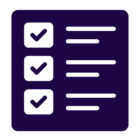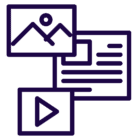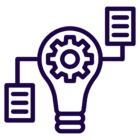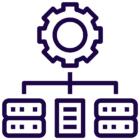Enterprise Knowledge (EK) commonly engages with organizations that are seeking to improve their existing Knowledge Management (KM) technology stack and, in turn, desire a new solution that is better suited to their technical and business requirements. There are several possible driving factors for this, including the need to refresh an outdated system, correct a previously failed implementation, supplement a system being used beyond its intended capabilities, or simply replace a system that doesn’t meet critical business needs. Despite an understanding of the need, many organizations don’t know where to start, or even what to consider, when making a KM technology transition.
Implementing a new KM system can be a daunting and complex process, and it can be especially challenging to take on without adequate analysis and understanding of your organization’s needs. EK has extensive industry experience within this space and can provide guidance and support on what the right system and implementation plan may be for your organization (see Common Mistakes Made When Selecting Knowledge Management Technology for more information on this topic). This blog provides an abbreviated glimpse into EK’s process for evaluating KM systems relative to organizational requirements, outlining six key considerations that are commonly used to determine which KM technology solution is the right fit for your organization.
1. What’s the right fit for your organization?
EK has worked with a wide array of clientele on assessing and implementing KM systems, and each engagement possesses its own set of unique characteristics and challenges that must be accounted for when assessing its KM capabilities. To understand these capabilities, EK begins by asking questions about the primary functionality of the new system.
Some common introductory questions include:
- Is this organization looking to re-platform a set of integrated technologies or a single tool?
- Are there existing systems in use that the new platform will need to be compatible with?
- What is going to primarily be stored and managed on the new system (i.e., documents, HR or legal information, images/videos, etc.)?
- How customized do you want this solution to be to your organization’s needs? Is there a preference for proprietary, out-of-the-box (OOTB) solutions vs. open-sourced and completely customizable ones?
- Is there any type of budgetary restriction? If so, what is it?
These questions are only the beginning of a very thorough discovery process, one that ideally results in the centralization of all relevant information concerning what an organization hopes to achieve with a new KM technology. This is key in narrowing down the types of systems that would be right for your organization, and provides a more comprehensive insight into its primary use cases, something that will be discussed further below.
2. What technical requirements are absolutely essential for the new KM system?
 It can be difficult to map out every technical requirement for a new KM system, and it can be even more arduous to prioritize them based on the needs and use cases of an organization. As tedious as it may be, this is crucial in assessing what capabilities must be addressed when implementing a new system.
It can be difficult to map out every technical requirement for a new KM system, and it can be even more arduous to prioritize them based on the needs and use cases of an organization. As tedious as it may be, this is crucial in assessing what capabilities must be addressed when implementing a new system.
Mapping out and prioritizing these requirements is an integral component of EK’s technical assessment process. EK takes an agile approach to understanding an organization’s technical requirements, and we initiate this approach by highlighting critical pain points and deficiencies of the existing system relative to the workflows of the organization. By assessing where the current KM system technically falls short of an organization’s needs, as well as engaging directly with stakeholders on what can be improved, EK can then define the capabilities that absolutely must be present within a new system, and prioritize those over requirements that would be “nice to have.” This enables EK to adequately identify and rank an array of potential options for your organization in a way that is tailored to its specific needs.
Some common initial technical questions include:
- What are the security concerns your organization has around its content?
- Are there unique features your KM system needs?
- What technologies does the system need to integrate with, such as SharePoint?
- Are there particular dashboards or aggregations?
- Will the system store structured (data and code; designed to be processed by systems) or unstructured (information; no rigid structure, designed to be readable by humans) content, or both?
- Is there a retention policy that needs to be considered? How will content be renewed or revisited?
- What security considerations should be considered?
EK recently partnered with a global development organization to formulate an implementation plan for a new KM system that would be used to store documentation for its international project teams. When assessing their existing KM system(s), EK identified many deficiencies that this organization was looking to fix, as well as several existing tools that could potentially fulfill these requirements. In order to prioritize the most critical capabilities for this new system, EK mapped out every relevant functionality from the discovery process and used the MoSCoW prioritization method (Must-Have, Should-Have, Could-Have, Won’t-Have) to differentiate which requirements were the most essential and would provide the most immediate value. EK was then able to cross-reference these requirements with the capabilities of potential vendors that EK had identified based on this organization’s use case, scoring each vendor’s ability to fulfill the necessary requirements and pinpoint which technical solution could be the right fit. While there are many different ways to prioritize technical requirements, it is imperative to the success of an engagement that some type of mapping and prioritization is conducted during the technical evaluation and selection process.
3. What is the current state of content in your organization?
 Once an organization has an idea of the type of system that is required, it is time to assess the current state of content that lives in the existing system(s). The first step in this process is identifying the current use cases and pain points surrounding the content needing to be accessed.
Once an organization has an idea of the type of system that is required, it is time to assess the current state of content that lives in the existing system(s). The first step in this process is identifying the current use cases and pain points surrounding the content needing to be accessed.
See below for common content related questions:
- What types of content needs to be accessed?
- Is the content standardized based on guidelines that govern consistency and quality?
- Is there too much content due to lack of governance, or too little as a result of a gap in content capture and creation efforts?
- How much of the content is duplicative or redundant?
- How much of the content is outdated or irrelevant?
- What are the current procedures (if any) for archiving and storing content?
- Is the content located in one repository or system or is it spread out among multiple?
- How much of the content would need to be migrated vs. left behind, archived, or deleted?
Not all of these questions will be pertinent to your organization or use case, but asking these types of questions will help your organization obtain a holistic understanding of its content and how it is being utilized, which helps to inform decisions related to selecting the right technology. It also further informs your organization on how its current capabilities are falling short, and what can be done to improve upon them.
4. Are there existing platforms, outside of the scope of the KM system, that are absolutely essential to workflows? Can they be integrated with the new system?
 Many organizations that EK engages with use multiple systems or platforms to comprise their technology stack, both for KM and for other, external applications and workflows. While it is extremely common for organizations to use multiple platforms in tandem with one another, it does present additional challenges. These challenges can take a variety of forms, but it is crucial to understand how the systems function with one another, and where (if at all) integration points exist.
Many organizations that EK engages with use multiple systems or platforms to comprise their technology stack, both for KM and for other, external applications and workflows. While it is extremely common for organizations to use multiple platforms in tandem with one another, it does present additional challenges. These challenges can take a variety of forms, but it is crucial to understand how the systems function with one another, and where (if at all) integration points exist.
Some core questions to ask include the following.
- Are there multiple systems being used for the same purpose, and if so, is consolidation possible?
- Can the systems “talk” to one another, or are there inherent technical limitations?
- What systems are absolutely essential to daily workflows across the organization that must be maintained when implementing a new KM system?
Asking these types of questions can make or break the success of your re-platforming initiative. If a new system is implemented and cannot integrate with the existing ones that are integral to other workflows, or equally if the wrong systems are consolidated, the engagement is destined to fail. This can result in significant additional development within the system itself (if even possible), or another re-platforming engagement entirely, either of which ultimately translate to increased bottom-line costs.
During a recent engagement, a creative technology organization partnered with EK to evaluate its KM technology stack. This organization possessed many similar technologies that overlapped in functionality and use case, and from an external perspective it seemed as though consolidation might be possible. Yet when taking a deeper dive into the technology stack and the exact functionality of each system, it became apparent that these technologies were integral to different workflows and creative outputs, and some employees and teams preferred one tool over another because it was better suited to their use case. While consolidation of tools may have made integrations with a KM system easier, it was much more important to prioritize and maintain the tools that enabled creativity and innovation, the very principles that drove the organization to be a global leader in its current space.
Understanding your organization’s workflows and the technologies that enable them plays a key role in the re-platforming process. Engaging with end users from across the organization to learn what tools they need to execute day-to-day responsibilities is a helpful place to start. Furthermore, thorough industry research on systems and integration points between them will go a long way in determining the overall success of your re-platforming engagement.
5. Does your organization need one tool, or several?
 Many organizations make the mistake of assuming a single “KM Technology” can address all of their KM needs. However, KM needs are broad and can run the gamut to include requirements around knowledge capture, data and information management, virtual collaboration, data and information findability, interoperability, and learning, amongst others. When seeking to fill technology gaps, it is critical for an organization to be open to several technologies, potentially from different vendors, rather than seeking to address everything with a single tool.
Many organizations make the mistake of assuming a single “KM Technology” can address all of their KM needs. However, KM needs are broad and can run the gamut to include requirements around knowledge capture, data and information management, virtual collaboration, data and information findability, interoperability, and learning, amongst others. When seeking to fill technology gaps, it is critical for an organization to be open to several technologies, potentially from different vendors, rather than seeking to address everything with a single tool.
For many organizations, this means identifying the gaps in their existing technology stack and finding the right solutions to fill those gaps, while simultaneously looking to integrate and enhance their existing systems. The best way to think about this is in terms of a technology ecosystem, where the KM suite is made up of multiple tools that need to be aligned from a design standpoint and integrated from a technical one.
It should also be noted there are vendors that offer comprehensive and “all-in-one” KM platforms that may be able to address all or most of your organization’s technical requirements, and while this may be applicable for some organizations, these types of solutions can be very expensive and require significant levels of time and effort to implement effectively. Though there are places where they may fit, each organization should be careful about an all-in-one solution’s ability to, in fact, deliver on all of the necessary technical and business requirements.
6. What does the future of work look like for your organization?
 A final consideration that has become especially relevant since the COVID-19
A final consideration that has become especially relevant since the COVID-19
pandemic and subsequent transition to a remote/hybrid workforce is understanding what the future of work looks like for your organization. Many are opting towards remote or hybrid working environments, while others are making the shift back to an all in-person work week. Regardless of what your organization is looking to do, understanding the implications of your organization’s plan for the future is essential in determining which KM system is the right fit. While nearly all systems offer remote capabilities in some capacity, there are some that are better suited to specific functionalities, like online collaboration and communication.
For example, not all KM systems allow for multiple users to edit the same document simultaneously, while others present different costs for the type and number of users (author, editor, viewer, etc.). Some vendors offer 24/7 remote support, while others offer it within a limited time frame or not at all. These types of services and capabilities may be more applicable to some organizations than others depending on your use cases and organizational abilities. Regardless, it is essential to understand what your organization needs to support its workflows, irrespective of geographic location or working structure.
Summary
This list is not exhaustive, nor are factors limited to those discussed above. This simply serves as a starting point for what to consider when undergoing a technical KM transformation. As challenging and complex as implementing a new KM system can be, breaking down the steps in a digestible manner using the considerations listed above can go a long way in preparing your organization for this type of initiative. If your organization is currently struggling with its existing KM technology stack and you are considering transitioning to a new one, please don’t hesitate to contact us Enterprise Knowledge.

